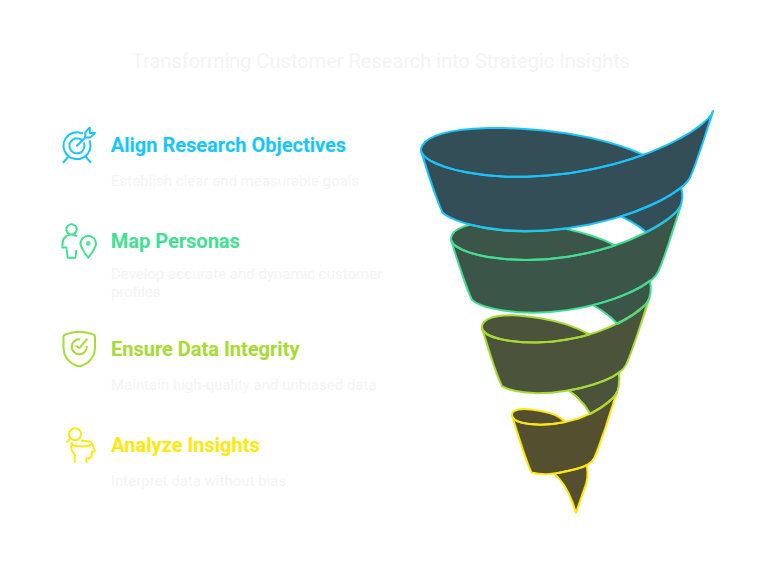Voice of Customer Research Strategy: 6 Steps to Deep Customer Insights
This guide unveils a systematic voice of customer research strategy that empowers you to decode complex customer behaviors, bridging the gap between data collection and genuine strategic understanding. By implementing these six strategic steps, you'll move beyond surface-level insights to uncover the nuanced perspectives driving real business decisions.
For customer insights professionals wrestling with fragmented feedback, unclear market signals, and disconnected research approaches, this methodology offers a breakthrough. You'll learn how to design research frameworks that don't just gather information, but generate actionable intelligence that directly informs product development, marketing positioning, and competitive differentiation.
Whether you're leading market research in a mid-sized enterprise or driving customer understanding for a growing organization, mastering voice of customer research isn't just a skill—it's your competitive advantage.
Why Voice of Customer Research Requires a Strategic, Step-by-Step Approach
Customer understanding isn't a luxury—it's a strategic imperative for businesses competing in complex B2B markets. Traditional research methods often fall short, producing fragmented insights that fail to capture the nuanced perspectives driving meaningful business decisions.
The Strategic Context: Understanding Voice of Customer Research Complexity
B2B decision-making involves intricate stakeholder networks, multifaceted purchasing processes, and rapidly evolving market dynamics. Unlike consumer markets, B2B environments demand deeper, more sophisticated research methodologies that can:
- Map complex organizational decision-making structures
- Decode professional motivations beyond surface-level feedback
- Translate qualitative insights into quantifiable strategic intelligence
- Track evolving industry trends and emerging customer expectations
A systematic voice of customer research strategy becomes crucial precisely because B2B markets resist simplistic, one-dimensional research approaches. Each interaction represents a potential opportunity to understand competitive positioning, product development trajectories, and unmet market needs.
Critical Challenges Undermining Effective Customer Research
Most organizations struggle with fundamental research obstacles that prevent genuine customer understanding:
Fragmented Feedback Channels
Siloed data collection methods prevent holistic insights, with customer perspectives scattered across disconnected platforms and departments.
Confirmation Bias
Research teams often unconsciously design studies that validate pre-existing assumptions rather than uncovering genuine customer perspectives.
Limited Contextual Understanding
Generic survey techniques fail to capture the nuanced professional contexts influencing B2B purchasing decisions and organizational priorities.
The Strategic Promise: Transforming Research into Actionable Intelligence
A structured, step-by-step voice of customer research strategy offers unprecedented advantages for forward-thinking organizations:
- Precision Insights: Move beyond generic feedback to laser-focused customer understanding
- Predictive Capabilities: Anticipate market shifts before competitors recognize emerging trends
- Cross-Functional Alignment: Create a unified understanding of customer needs across product, marketing, and sales teams
- Strategic Agility: Develop responsive research frameworks that evolve with market dynamics
By implementing a rigorous, systematic approach, businesses transform customer research from a passive information-gathering exercise into a dynamic strategic tool that directly influences product development, market positioning, and competitive differentiation.
Voice of customer research isn't about collecting data—it's about generating strategic intelligence that creates measurable business value.
The forthcoming step-by-step tutorial will equip market research professionals with a comprehensive methodology to break through traditional research limitations, delivering insights that are not just informative, but truly transformative.
6-Step Voice of Customer Research Strategy for B2B Insights

Step 1: Define Research Objectives with Precision
Strategic customer research begins with laser-focused objectives that transcend generic data collection. Your research must connect directly to specific business outcomes.
- Identify key strategic questions driving the research initiative
- Align research goals with specific business challenges or growth opportunities
- Establish clear, measurable criteria for successful insights
Pro Tip
Collaborate across departments to ensure research objectives reflect cross-functional priorities, not just departmental interests.
Step 2: Develop a Comprehensive Customer Persona Mapping
B2B customer understanding requires deep, multidimensional persona development that captures professional motivations and organizational contexts.
- Create detailed professional profiles beyond demographic data
- Map decision-making hierarchies within target organizations
- Identify pain points across different stakeholder levels
Recommended Tools
Use platforms like Lucidchart or Smaply for comprehensive persona mapping and stakeholder journey visualization.
Step 3: Design Multi-Modal Research Instruments
Effective voice of customer research demands a sophisticated, integrated approach that captures nuanced insights across different engagement channels.
- Combine qualitative and quantitative research methods
- Develop semi-structured interview protocols
- Design targeted surveys with open-ended and structured questions
Pro Tip
Incorporate contextual inquiry techniques that allow deeper exploration of professional environments and decision-making processes.
Step 4: Execute Rigorous Data Collection
Strategic data collection requires methodical approaches that ensure representative and unbiased customer perspectives.
- Implement stratified sampling techniques
- Establish clear participant selection criteria
- Create standardized documentation protocols
Recommended Tools
Leverage platforms like Qualtrics or UserInterviews for systematic research participant recruitment and management.
Step 5: Advanced Insight Analysis
Transform raw data into strategic intelligence through sophisticated analytical frameworks that uncover hidden patterns and actionable insights.
- Apply thematic coding techniques
- Use sentiment analysis algorithms
- Create correlation matrices across research dimensions
Pro Tip
Utilize machine learning algorithms to identify emerging trend signals within complex datasets.
Step 6: Strategic Insight Activation
Convert research findings into organizational intelligence that drives strategic decision-making across product development, marketing, and sales functions.
- Develop comprehensive insights reports
- Create cross-functional presentation frameworks
- Design actionable recommendation matrices
Recommended Tools
Use visualization platforms like Tableau or PowerBI to transform complex insights into compelling strategic narratives.
Troubleshooting Your Voice of Customer Research Strategy: Common Challenges and Solutions
Even the most meticulously planned voice of customer research can encounter significant roadblocks. Understanding these potential challenges is crucial for maintaining research integrity and extracting meaningful insights.
Research Objective Alignment Challenges
Common Issues:
- Misaligned departmental priorities
- Overly broad or vague research goals
- Lack of cross-functional buy-in
Solution Strategies:
- Conduct a preliminary stakeholder workshop to establish clear, measurable research objectives
- Create a cross-functional research charter that explicitly links research goals to strategic business outcomes
- Develop a governance model that ensures ongoing alignment and accountability
Persona Mapping Complexity
Common Pitfalls:
- Superficial persona development
- Incomplete stakeholder mapping
- Reliance on outdated or assumptions-based personas
Mitigation Approaches:
- Implement continuous persona validation through regular interviews
- Use dynamic persona tracking tools that capture real-time professional context changes
- Integrate multiple data sources, including LinkedIn, industry reports, and direct customer interactions
Data Collection Integrity Challenges
Potential Research Risks:
- Sample bias
- Participant selection limitations
- Response quality inconsistencies
Robust Mitigation Strategies:
- Develop multi-channel recruitment strategies
- Implement rigorous screening protocols
- Use triangulation techniques to validate insights across different research methods
Insight Analysis and Translation Obstacles
Analysis Challenges:
- Confirmation bias in data interpretation
- Overcomplicating analytical frameworks
- Difficulty translating qualitative insights into actionable strategies
Advanced Resolution Techniques:
- Utilize blind analysis protocols to minimize researcher bias
- Develop standardized insight translation frameworks
- Create cross-functional insight review sessions to challenge interpretations
Effective voice of customer research isn't about avoiding challenges—it's about developing systematic approaches to navigate and overcome them strategically.
Transforming Customer Research into Strategic Advantage

By methodically implementing this voice of customer research strategy, market research professionals unlock a powerful framework for generating actionable business intelligence. The journey from fragmented data to strategic insights represents more than a research process—it's a fundamental transformation of how organizations understand and engage with their customers.
Key Business Improvements
- Precision Decision-Making: Replace intuition-based strategies with data-driven insights that directly inform product development and market positioning
- Competitive Differentiation: Develop a nuanced understanding of customer needs that enables unique value propositions
- Organizational Alignment: Create a unified customer perspective that bridges gaps between marketing, sales, and product teams
- Predictive Market Intelligence: Build capabilities to anticipate market shifts before they become apparent to competitors
Success Measurement Metrics
- Customer Insight Depth Index: Quantify the comprehensiveness of customer understanding across organizational functions
- Strategic Recommendation Conversion Rate: Track how research insights translate into implemented business strategies
- Market Responsiveness Time: Measure the speed at which your organization can adapt to emerging customer needs
- Cross-Functional Alignment Score: Assess how effectively research insights are shared and utilized across departments
Market research professionals who master this systematic approach will transform customer research from a passive information-gathering exercise into a dynamic strategic capability that drives measurable business value.
Conclusion: Mastering Voice of Customer Research Strategy
Implementing a robust voice of customer research strategy is not just about collecting data, but about transforming insights into actionable intelligence that drives strategic decision-making. By embracing a holistic approach that combines sophisticated methodological frameworks, advanced analytical techniques, and a deep commitment to understanding customer nuances, market research professionals can unlock unprecedented levels of customer understanding. The most successful organizations recognize that VOC research is a continuous, iterative process that requires agility, empathy, and a systematic approach to capturing, analyzing, and operationalizing customer feedback across multiple touchpoints and channels. As the market landscape becomes increasingly complex and customer expectations continue to evolve rapidly, those who master the art and science of voice of customer research will gain a significant competitive advantage, enabling them to anticipate market shifts, personalize customer experiences, and drive meaningful business transformation.
